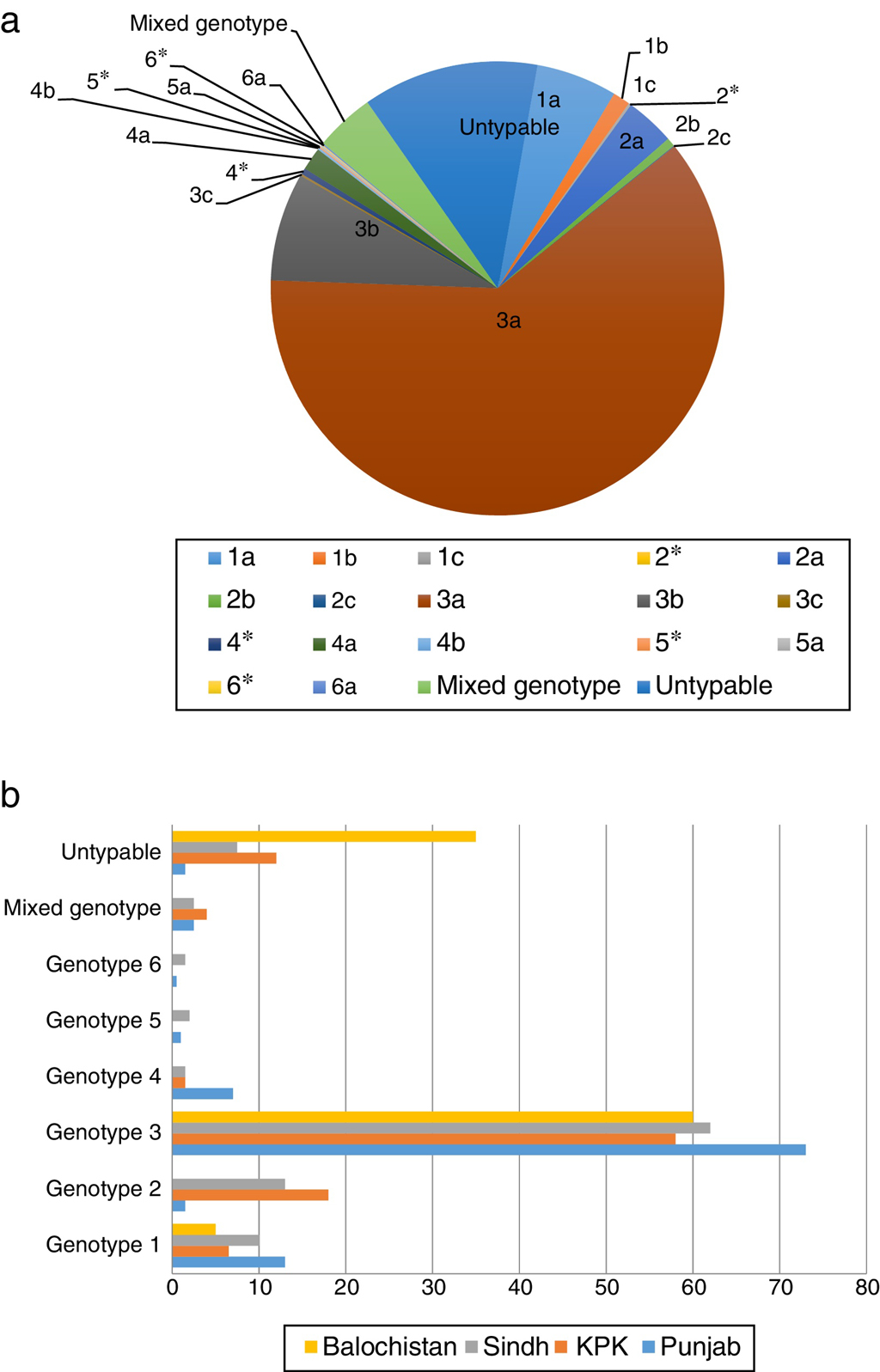Dear Editor,
A recent article by Gul et al.11 Gul A, Ahmed J, Zahir F, Ali Khan I, Ali I. New patterns of HCV subtypes distribution in the Khyber Pakhtunkhwa province of Pakistan. Braz J Infect Dis. 2016;20:107–8. highlights an important issue of Hepatitis C Virus (HCV) subtypes sero-prevalence in the Khyber Pakhtunkhwa (KPK) province of Pakistan. It is the first report of its kind on the changing epidemiological pattern of HCV genotypes in the province. The results of the study showed an increase in mixed HCV subtypes (22.9%) and genotype 1a (11.6%) and decrease in 3a genotype (45.5%).11 Gul A, Ahmed J, Zahir F, Ali Khan I, Ali I. New patterns of HCV subtypes distribution in the Khyber Pakhtunkhwa province of Pakistan. Braz J Infect Dis. 2016;20:107–8. The outcome of interferon plus ribavirin therapy is viral genotype specific, some genotypes/subtypes being good responders while others are not. Keeping in view the importance of sero-prevalent viral genotype regarding the management of patients, we analyzed the previous reports (26 published studies) from Pakistan on prevalence of HCV genotypes. The existing data showed that genotype 3a (57.37) is the most common genotype in the country while the prevalence of 1b subtype is only 1.985% and 1a is 5.93% (Fig. 1a), which support the study by Gul et al.11 Gul A, Ahmed J, Zahir F, Ali Khan I, Ali I. New patterns of HCV subtypes distribution in the Khyber Pakhtunkhwa province of Pakistan. Braz J Infect Dis. 2016;20:107–8. The analysis of previous published results regarding province wise distribution of the viral genotypes showed that 3a is the major circulating viral genotype in all four provinces of the country but the distribution of other viral clades is differential (Fig. 1b). By comparing the previously published results with the current report by Gul et al. it is evident that the pattern of HCV subtypes is changing in the region.
Relative frequency distribution of HCV subtypes in Pakistan. * Subtype not defined (a) and province-wise distribution pattern of major HCV genotypes (b).
Due to the error prone nature of viral polymerase, HCV has many genotypes and subtypes. The interferon therapy response is genotype dependent and different viral genotypes showed varied level of sustained virological response (SVR). Among all viral genotypes 3a has shown to be a good responder to interferon therapy.22 Afzal MS, Anjum S, Zaidi NU. Effect of functional interleukin-10 polymorphism on pegylated interferon-α plus ribavirin therapy response in chronic hepatitis C virus patients infected with 3a genotype in Pakistani population. Hepat Mon. 2013;13:e10274, http://dx.doi.org/10.5812/hepatmon.10274.
http://dx.doi.org/10.5812/hepatmon.10274...
Pakistan is a resource constrained country with very low per capita income and considerably low expenditure on health by the Government (just 2.7% of GDP).33 Afzal MS, Khan MY, Ammar M, Anjum S, Zaidi NU. Diagnostically untypable hepatitis C virus variants: it is time to resolve the problem. World J Gastroenterol. 2014;20:17690–2, http://dx.doi.org/10.3748/wjg.v20.i46.17690.
http://dx.doi.org/10.3748/wjg.v20.i46.17...
It ranked second in the world in terms of HCV infection with more than 10 million infections.33 Afzal MS, Khan MY, Ammar M, Anjum S, Zaidi NU. Diagnostically untypable hepatitis C virus variants: it is time to resolve the problem. World J Gastroenterol. 2014;20:17690–2, http://dx.doi.org/10.3748/wjg.v20.i46.17690.
http://dx.doi.org/10.3748/wjg.v20.i46.17...
As the data indicates that 3a, supposedly to be a good responder to therapy, is the most prevalent genotype in the country most of the treated individuals with interferon therapy should attain SVR. Accordingly, a most recent report (2014) from Pakistan regarding response of different HCV genotypes to interferon therapy showed 95% SVR in 3a infections in contrast to only 34% of 1b infections.44 Iqbal S, Khalil-Ur-Rahman, Sheikh MA, Arshad M. Response of different HCV genotypes to interferon therapy in different age groups of chronic hepatitis-C patients. J Ayub Med Coll Abbottabad. 2014;26:310–5. The current shift in the circulating viral genotype enlighten an important upcoming danger. Health care workers may face problems to successfully treat patients as it will be more difficult for patients to achieve SVR. For achieving higher rates of SVR antiviral therapy will have to be extended thus increasing the economic burden on society and psychology trauma on the patients and their families. SVR rates are greatly increased with direct acting antivirals (DAA) therapy but the high cost is a major obstacle.55 Raza H, Ahmad T, Afzal MS. HCV, interferon therapy response, direct acting antiviral therapy revolution and Pakistan: future perspectives. Asian Pac J Cancer Prev. 2015;16:5583–4. In Pakistan, the allocated budget for health is already pretty low and the country is also endemic for other viral infections like polio and dengue which would result in shifting of priorities. By viewing the forthcoming giant of HCV therapy resistance, it is needed to properly monitor the pattern of HCV genotypes in the country. A well developed surveillance system is highly needed to timely tackle the upcoming problem.
Role of the funding source
There is no role of any funding agency in this study.
Conflicts of interest
The authors declare no conflicts of interest.
References
-
1Gul A, Ahmed J, Zahir F, Ali Khan I, Ali I. New patterns of HCV subtypes distribution in the Khyber Pakhtunkhwa province of Pakistan. Braz J Infect Dis. 2016;20:107–8.
-
2Afzal MS, Anjum S, Zaidi NU. Effect of functional interleukin-10 polymorphism on pegylated interferon-α plus ribavirin therapy response in chronic hepatitis C virus patients infected with 3a genotype in Pakistani population. Hepat Mon. 2013;13:e10274, http://dx.doi.org/10.5812/hepatmon.10274
-
3Afzal MS, Khan MY, Ammar M, Anjum S, Zaidi NU. Diagnostically untypable hepatitis C virus variants: it is time to resolve the problem. World J Gastroenterol. 2014;20:17690–2, http://dx.doi.org/10.3748/wjg.v20.i46.17690
-
4Iqbal S, Khalil-Ur-Rahman, Sheikh MA, Arshad M. Response of different HCV genotypes to interferon therapy in different age groups of chronic hepatitis-C patients. J Ayub Med Coll Abbottabad. 2014;26:310–5.
-
5Raza H, Ahmad T, Afzal MS. HCV, interferon therapy response, direct acting antiviral therapy revolution and Pakistan: future perspectives. Asian Pac J Cancer Prev. 2015;16:5583–4.
Publication Dates
-
Publication in this collection
May-Jun 2016
History
-
Received
14 Dec 2015 -
Accepted
28 Dec 2015


